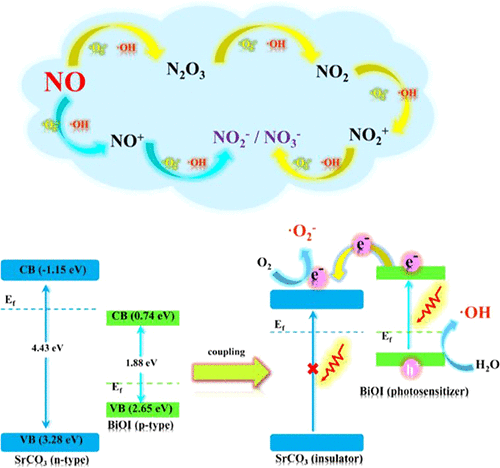当前位置:
X-MOL 学术
›
Environ. Sci. Technol.
›
论文详情
Our official English website, www.x-mol.net, welcomes your feedback! (Note: you will need to create a separate account there.)
Unraveling the Mechanisms of Visible Light Photocatalytic NO Purification on Earth-Abundant Insulator-Based Core–Shell Heterojunctions
Environmental Science & Technology ( IF 11.4 ) Pub Date : 2018-01-08 00:00:00 , DOI: 10.1021/acs.est.7b05457 Hong Wang 1 , Yanjuan Sun 1 , Guangming Jiang 1 , Yuxin Zhang 2 , Hongwei Huang 3 , Zhongbiao Wu 4 , S. C. Lee 5 , Fan Dong 1
Environmental Science & Technology ( IF 11.4 ) Pub Date : 2018-01-08 00:00:00 , DOI: 10.1021/acs.est.7b05457 Hong Wang 1 , Yanjuan Sun 1 , Guangming Jiang 1 , Yuxin Zhang 2 , Hongwei Huang 3 , Zhongbiao Wu 4 , S. C. Lee 5 , Fan Dong 1
Affiliation

|
Earth-abundant insulators are seldom exploited as photocatalysts. In this work, we constructed a novel family of insulator-based heterojunctions and demonstrated their promising applications in photocatalytic NO purification, even under visible light irradiation. The heterojunction formed between the insulator SrCO3 and the photosensitizer BiOI, via a special SrCO3–BiOI core–shell structure, exhibits an enhanced visible light absorbance between 400–600 nm, and an unprecedentedly high photocatalytic NO removal performance. Further density functional theory (DFT) calculations and X-ray photoelectron spectroscopy (XPS) analysis revealed that the covalent interaction between the O 2p orbital of the insulator (SrCO3, n-type) and the Bi 6p orbital of photosensitizer (BiOI, p-type) can provide an electron transfer channel between SrCO3 and BiOI, allowing the transfer of the photoexcited electrons from the photosensitizer to the conduction band of insulator (confirmed by charge difference distribution analysis and time-resolved fluorescence spectroscopy). The •O2– and •OH radicals are the main reactive species in photocatalytic NO oxidation. A reaction pathway study based on both in situ FT-IR and molecular-level simulation of NO adsorption and transformation indicates that this heterojunction can efficiently transform NO to harmless nitrate products via the NO → NO+ and NO2+ → nitrate or nitrite routes. This work provides numerous opportunities to explore earth-abundant insulators as visible-light-driven photocatalysts, and also offers a new mechanistic understanding of the role of gas-phase photocatalysis in controlling air pollution.
中文翻译:

阐明基于地球绝缘子的核-壳异质结上可见光光催化NO净化的机理
很少使用富含地球的绝缘体作为光催化剂。在这项工作中,我们构建了一个新的基于绝缘子的异质结家族,并展示了它们在光催化NO净化(甚至在可见光照射下)中的应用前景。通过特殊的SrCO 3 -BiOI核-壳结构,在绝缘体SrCO 3和光敏剂BiOI之间形成的异质结在400-600 nm之间具有增强的可见光吸收率,并具有前所未有的高光催化NO去除性能。进一步的密度泛函理论(DFT)计算和X射线光电子能谱(XPS)分析表明,绝缘子(SrCO 3,n型)和光敏剂的Bi 6p轨道(BiOI,p型)可以在SrCO 3和BiOI之间提供电子转移通道,从而使光激发电子从光敏剂转移到绝缘体的导带(由确认)。电荷差异分布分析和时间分辨荧光光谱)。•O 2 –和•OH自由基是光催化NO氧化的主要反应性物质。基于原位FT-IR和分子水平模拟NO吸附和转化的反应途径研究表明,该异质结可以通过NO→NO +和NO 2 +有效地将NO转化为无害的硝酸盐产物→硝酸盐或亚硝酸盐路线。这项工作为探索作为可见光驱动的光催化剂的富含地球的绝缘子提供了许多机会,并且为气相光催化在控制空气污染中的作用提供了新的机理理解。
更新日期:2018-01-08
中文翻译:

阐明基于地球绝缘子的核-壳异质结上可见光光催化NO净化的机理
很少使用富含地球的绝缘体作为光催化剂。在这项工作中,我们构建了一个新的基于绝缘子的异质结家族,并展示了它们在光催化NO净化(甚至在可见光照射下)中的应用前景。通过特殊的SrCO 3 -BiOI核-壳结构,在绝缘体SrCO 3和光敏剂BiOI之间形成的异质结在400-600 nm之间具有增强的可见光吸收率,并具有前所未有的高光催化NO去除性能。进一步的密度泛函理论(DFT)计算和X射线光电子能谱(XPS)分析表明,绝缘子(SrCO 3,n型)和光敏剂的Bi 6p轨道(BiOI,p型)可以在SrCO 3和BiOI之间提供电子转移通道,从而使光激发电子从光敏剂转移到绝缘体的导带(由确认)。电荷差异分布分析和时间分辨荧光光谱)。•O 2 –和•OH自由基是光催化NO氧化的主要反应性物质。基于原位FT-IR和分子水平模拟NO吸附和转化的反应途径研究表明,该异质结可以通过NO→NO +和NO 2 +有效地将NO转化为无害的硝酸盐产物→硝酸盐或亚硝酸盐路线。这项工作为探索作为可见光驱动的光催化剂的富含地球的绝缘子提供了许多机会,并且为气相光催化在控制空气污染中的作用提供了新的机理理解。



























 京公网安备 11010802027423号
京公网安备 11010802027423号